Take one Chevrolet 'Cross-Fire Injection' EFI intake manifold, convert to carburetor. Why? I forgot to put the aluminum foil under my hat, and the Voices made me do it. They sounded a lot like Bruce Plecan from the low- fanglers' list. Bruce has been running a converted Cross-Fire with a Quadrajet on a 350 Chevy for quite a while.
The Cross-Fire intake has little tiny runners, about 2/3 the size of standard Chevy dual plane runners. The hot rod types throw up their hands in horror and run away. Chevy designed the intake to make good low and mid range power, and it does... and it's not anywhere near as bad at high RPM as it looks. The 2/3-size runners are the *top* 2/3 of the ports, which probably flow about 3/4 of the air... and the intake isn't as much of a restriction as the bowl area anyway.
The Cross-Fire runners are short and straight - you can look through to daylight on every one. The large step on the floor of the port helps break up fuel droplets heading into the port, and it acts as an overlap dam for air trying to flow the other way.
I forwarded some of Bruce's messages to my brother, who has a 311 Chevy small block with the late corkscrew-port heads and an Offy Dual-Port intake. I had found through experimentation (water hose in the intake port) that the corkscrew heads got maximum swirl with the air stream directed to the top of the port. The Offy directs air to the bottom of the port, as the lower plenum is the primary plenum. Not optimal, but the best we could do.
In conjunction with the Cross-Fire, though, things looked much better. And the big Iskenderian cam Kevin had installed back when he was running 4.56 gears would probably work better with the Cross-Fire than the Dual Port. So I snagged a Cross-Fire at the local salvage yard and began tinkering.

Removing the EGR dong is the first thing most Cross-Fire guys do, and for good reason...
Note the straight intake ports. The entire bottom of the plenum is water
heated; water flows from the backs of the cylinder heads for four-corner
cooling, just like the newest racing intakes.
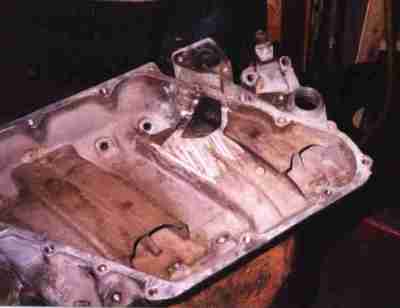
Some of the Cross-Fire guys cut the tops of the runners back to get more top end air flow. We're not doing that for Kevin's 311; if he wanted more top end air flow, he'd've started with a Victor Jr. or something.
The Cross-Fire intakes are all for the old-type cylinder heads with the center
intake bolts at the same angle as the end bolts. Kevin has the late model
heads with the center bolts stood up at a sharper angle. He'll have to slot
the holes to match his heads and use his wedge washers from the Dual Port.
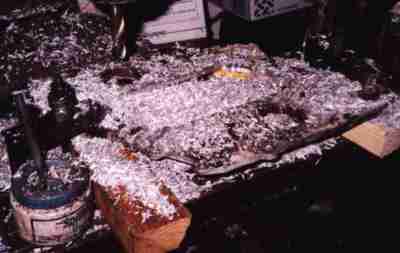
The long center hole I machined gives a little extra plenum volume and will
help direct fuel to the ends of the intake. I could pretend I did I
deliberately, but in reality I sort of got carried away with the cutter.
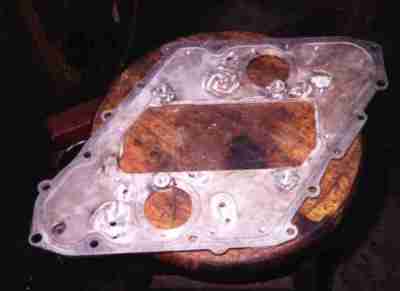
You can see how each TBI unit sat at the end of the crossbar of the "H" in the
plenum. The carburetor will sit in the middle of the "H".
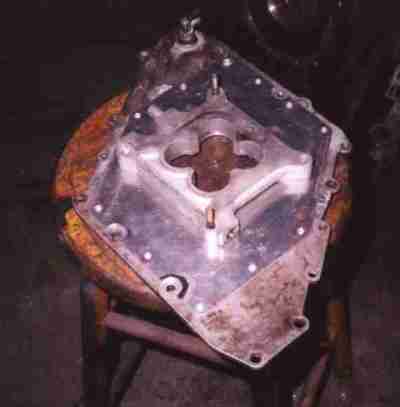
The 1" water heated carb spacer is from a 1964 Ford pickup truck. It's tapped
for 1/4" NPT pipe fittings. I wanted an open spacer, but when I looked
closely at how the water passages ran in the casting (a U shape around the
side) it looked like the water passage might bulge into the center at the "X"
part, so I just trimmed it into a cloverleaf.
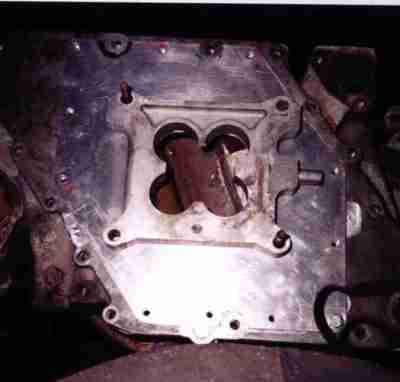
This photo is sort of dark, but you can see that the carb is pretty well
centered over the "H". The cloverleaf lets the rear cylinders pull more
cleanly from the primaries. That's the theory, anyway. It'll be a tempest in
a teapot in there with the engine running, which is good for fuel/air mixing.
The water-heated floor will re-introduce any droplets to the air as vapor.
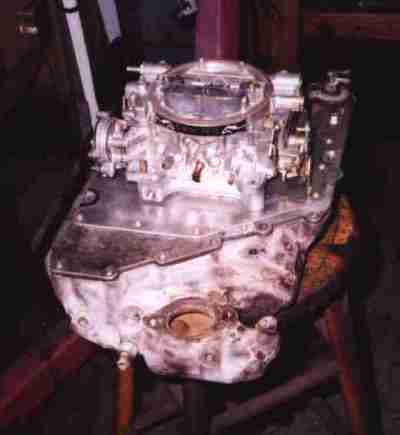
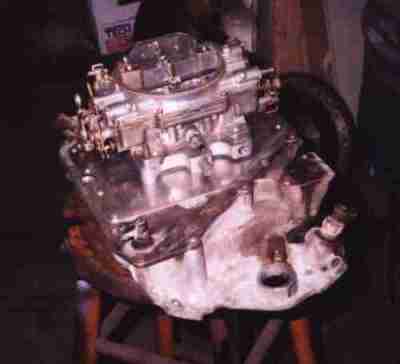
The racer guys want a cool carburetor; we want a warm one for easier operation in cold weather and better fuel vaporization the rest of the time.
After this shot I got wild and milled and ground that apple-sized EGR mounting
knob off. It blocked access to the distributor hold-down bolt, and it was
ugly. If Kevin wants to play with EGR he can use a carb spacer with an EGR
mount; more junkyard fangle. I did some more welding over the holes after
removing the EGR knob, and Kevin finished up the grinding and used epoxy to
smooth it all out.
After Kevin got the intake in hand he cleaned it all up, slotted the center bolt holes, finished up the work on the EGR blockoffs, painted it to match the engine, and bought a handful of stainless steel bolts and washers to spiff it up some.
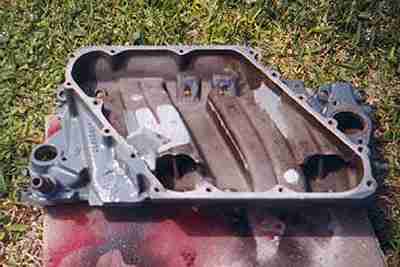
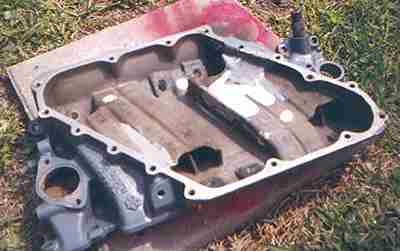
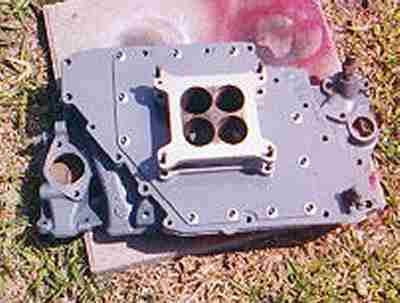
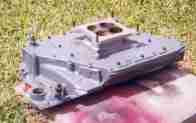
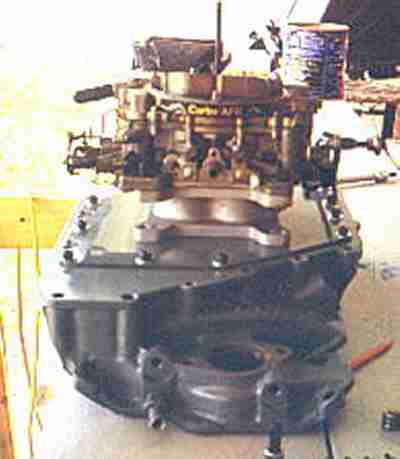
He still doesn't have the 311 in the truck yet - the 283 is still chugging along - but he's quite pleased with his new Cross-Fire intake anyway. Shortly after taking these pictures he pulled the Offy Dual-Port intake off and bolted the Cross-Fire down.
Results: he has to pump it once or twice for a cold start, as usual. (he's running without a choke) Throttle response is even better than the Dual Port! It pulls very hard up to around 4000 RPM, then the engine lays down. Our theory is that the large plenum is damping the usual reversion signals the carb sees, causing it to go lean. He's ordered a jetting kit and will attend to that ASAP.
Kevin said the most interesting thing about the Cross-Fire is the sound. He says it makes a rumbly noise you can easily hear from the driver's seat, even over wind, tire, and exhaust racket. He likes the sound, but was quite surprised to hear it.
note 1:
If you like the concept of the Cross-Fire, but you don't care for the
small runners, Offenhauser makes a racing intake that's very similar, with
racing-size runners and plenum volume. The base is about $225, and lids are
$125 for 1x4, 2x4, or 3xWeber carburetion. I'd love to mount a set of
injectors in the lid shooting down at the ports to get maximum vaporization of
the fuel along the runners.
If Kevin decides to go back to EFI with the Cross-Fire, we might mount one of those 3" LS-1 throttle bodies where the carb is now and weld eight injector bungs into the lid.
note 2:
The original Cross-Fire manifold-to-head gaskets had a small water
hole at the rear water opening on the head intake face. The early style
gaskets had a big hole just like at the front. Later model TBI intakes also
have a gasket with a small, restricted hole at the back. Lore has it that
using the early type gaskets will cause the engine to overheat.
At first we were skeptical - Kevin is using the early gaskets - but after some discussion we came up with a theory, since GM and reputable mechanics have insisted the wrong gasket will make the engine overheat. The Cross-Fire and the TBI intakes are both water jacketed and have "four corner cooling"; that is, instead of just blank metal back there at the manifold to head junction, there's a water passage in the manifold. Water flows through the restrictor orifice in the gasket, through the intake, mixes with water from the front, and exits via the thermostat.
The water pump forces water into the block. There are various small holes, then the water goes into the heads, then out via the intake. You can best think of the water system as a set of plenums - a block plenum and a head plenum on each side. The head gasket is the restrictor between the plenums. Water flow and pressure is much the same at both ends of the block. The water seeps into the heads, and then is borne off in a stream toward the front, with the flow biased across the exhaust port areas. This steady stream (with the thermostat open or floating) circulates coolant around the hottest part of the heads.
With water flow exiting both ends of the head, there's no circulation to move water across the paired center ports, which would then start boiling coolant. The way we figure it, you can restrict *either* end of the head; it doesn't matter which way the coolant flows, just that it moves the length of the head plenum. Kevin wants as much heat in the intake as possible, so when he moves the engine to the 311 he'll use the late model gaskets, reversed so the main coolant flow is out the back.
Why doesn't the 283 overheat? Because it's not making much power, has the same water pump as a 350 or 400, and the truck has a four row radiator that's about the size of a card table. If it was a late 350 with a more highly stressed cooling system, it would probably puke coolant out the overflow when you leaned on it hard. Or so we guess.
-30-